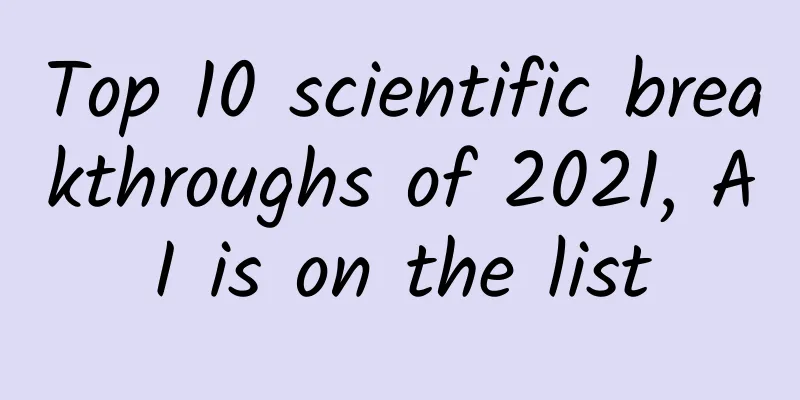Top 10 scientific breakthroughs of 2021, AI is on the list

|
On November 17, 2021, Science magazine released the 2021 annual scientific breakthrough list, with AlphaFold and RoseTTA-fold, two artificial intelligence-based technologies for predicting protein structure, ranking first. In addition, scientific breakthroughs of the year include: development of antiviral drugs for COVID-19, new measurements of muons, observations of Mars earthquakes, recovery of ancient human DNA from soil, in vivo applications of CRISPR, new insights into early human development, use of psychedelic drugs to treat PTSD, development of monoclonal antibodies for treating infectious diseases, and advances in fusion energy generation. In addition, Science magazine also selected three scientific breakdowns of the year, including the slim hope of achieving climate goals, the anger caused by Alzheimer's disease drugs, and scientists being ostracized and attacked because of the new crown epidemic. This article mainly introduces the most important scientific breakthrough of this year - protein structure prediction based on artificial intelligence. Structural biology has been a puzzle for more than 50 years We all know that protein is the main bearer of life activities. It is no exaggeration to say that there is no life without protein. Therefore, protein has long been the focus of research by life scientists. Among them, the structure of protein is a hot topic for many life scientists. After all, its main function is determined by the structure. In 1957, John C. Kendrew and Max F. Perutz determined the first protein structure by X-ray crystallography. Soon after, Christian B. Anfinsen Jr. proposed that the structure of proteins was thermodynamically stable and that it seemed possible to predict the three-dimensional structure of a protein based on its amino acid sequence. However, the structural complexity of proteins is far beyond people's imagination. According to the central dogma, proteins are mainly assembled from DNA transcription into RNA, then translated into peptide chains. A protein molecule is composed of one or several polypeptide chains, which are folded into a unique shape. At the same time, the specific shape of protein molecules is determined by four levels of structure, including primary, secondary, tertiary and quaternary structures, and the previous level structure determines the next level structure. The amino acid sequence of the polypeptide chain is the primary structure, and part of the polypeptide chain in the primary structure curls or folds to produce a secondary structure. The secondary structure undergoes a series of conformational changes to form a three-dimensional structure, namely the tertiary structure, which is generally spherical or fibrous. The tertiary structure has specific domains, forming binding sites or regulatory sites, which can bind to substances of specific structures and perform specific functions. Proteins composed of two or more polypeptide chains can form a quaternary structure. Figure | Protein 3D structure (Source: Nat Commun) Therefore, in the more than 50 years since Christian B. Anfinsen Jr. proposed his theory, scientists have been unable to solve the problem of protein folding, and their understanding of protein structure is still very limited. In recent years, with the development of cryo-electron microscopy technology, protein structure can be observed without crystallized samples, which has made progress in protein structure research. However, cryo-electron microscopy is a very expensive device, which is only available in a very small number of laboratories, making it very unfriendly to the majority of scientific researchers. Therefore, the life science community is in urgent need of new methods to solve the protein folding problem. AI helps solve the problem of protein structure prediction With the development of computer science, some scholars have proposed using computer models to solve the problem of protein folding. Although this idea is feasible, in the following decades, the accuracy of various computer models developed by people in predicting protein structure has always been limited. Over the past 25 years, the International Competition for Protein Structure Prediction (CASP) has been focusing on the progress in this field, trying to find a computer model that can perfectly solve the protein folding problem. Until the 14th competition, CASP14, was successfully held, DeepMind's AlphaFold system showed unparalleled accuracy in protein structure prediction. The evaluation method of the competition is to compare the solutions provided by the contestants with the "gold test standard" and measure the accuracy with the GDT score, which ranges from 0 to 100. A GDT score of around 90 points can be considered competitive with human experimental methods. The total score of DeepMind's AlphaFold system reached 92.4, with an error of 1.6 from the experiment. Even on the most difficult protein without a homologous template, this score reached a terrifying 87.0. At the same time, AlphaFold's neural network can predict the structure of a typical protein in a few minutes, and can also predict the structure of larger proteins (such as a protein containing 2180 amino acids and no homologous structure). The model can accurately estimate the reliability of its prediction based on each amino acid, making it easier for researchers to use its prediction results. Figure | 3D view of human interleukin 12 binding to its receptor predicted by researchers using RoseTTAFold (Source: UW Medicine Institute for Protein Design) Subsequently, in July of this year, David Baker, professor of biochemistry at the University of Washington School of Medicine and director of the Institute for Protein Design, led a team of computational biologists to successfully develop a tool called RoseTTAFold, which is based on deep learning and can quickly and accurately predict the structure of the target protein based on limited information, achieving an accuracy comparable to AlphaFold2. Not only that, RoseTTAFold requires less computing energy and computing time than AlphaFold2: using only a gaming computer, the protein structure can be reliably calculated in just ten minutes. What’s more noteworthy is that the code and server of RoseTTAFold are completely free to the scientific community! Image | David Baker (Source: University of Washington official website) Since July, the relevant program has been downloaded for free from GitHub by more than 140 independent scientific research teams, and scientists from all over the world are now using RoseTTAFold to build protein models to accelerate research in related fields. Also in July this year, DeepMind founder and CEO Demis Hassabis shared AlphaFold's open source code in Nature magazine and published a complete methodology for the system, detailing how AlphaFold accurately predicts protein 3D structures. In other words, this powerful protein structure prediction model is now completely free. At this point, the two powerful AI-based protein structure prediction models are now fully open to the public for free. Researchers can use these two models to obtain the spatial structure of proteins at any time without having to crystallize the proteins or use expensive cryo-electron microscopy for research. In a commentary published simultaneously, Holden Thorp, editor-in-chief of Science magazine, said, "First, it solves the protein folding problem that has plagued life sciences for nearly 50 years. It is like gravitational waves in physics. Scientists have worked tirelessly for decades to finally overcome this problem. Second, this technology changes the rules of future structural biology, just like cryo-electron microscopy, accelerating the development of life sciences. In addition, it is completely free, which means it is a protein prediction model that is truly suitable for everyone." References: https://www.eurekalert.org/news-releases/937705? www.science.org/doi/10.1126/science.abn5795 Written by: Zhu Hengheng Editor: Wang Haha Layout: Li Xuewei Source: Academic Headlines |
<<: I look 10 years older after my whites of my eyes turned yellow...
>>: Secret Ailao | What are the treasures in Ailao Mountain and where are the dangers?
Recommend
Finally, we've got you! WeChat for Android will be updated with dark mode
March 10th news, recently, the dispute between Te...
6 types of short video cover copywriting, collection~
Short video operators should know that in order f...
Xinchi and Juefei start strategic cooperation, and China's autonomous driving industry enters the "core" path
Recently, CoreDrive Technology officially release...
Brilliance Automotive Group has finally learned something from BMW. Can the Brilliance Automotive Group V7 create a miracle?
When talking about Zhonghua, what do you think of...
When you drink tea bags, drip coffee, or chew gum, you are probably also eating plastic.
Do you know how much plastic there is in our live...
WeChat has been updated again. Have you noticed these four practical little features?
As a domestic instant messaging tool, WeChat has ...
Short video promotion skills in the home improvement industry, with successful cases!
Advertising is the first impression that consumer...
Dong Mingzhu: We develop all the software and hardware for our mobile phones ourselves
[[145878]] Gree, which started the price war of a...
5 Best Paid App Promotion Methods in 2015
Nowadays, if an APP wants to survive, it must hav...
Anonymous social networking is no longer popular, but Secret China’s WeChat account is popular
I don’t know how things are going on there, but t...
The shortcut from a novice to an expert in SEM bidding, you will regret it if you don’t read it!
The growth path of SEMer is a process of fighting...
First experience with Hujiang Online School’s CET-4 smart course: Is it reliable to pass the CET-4 easily for 29 yuan?
For many college students, CET-4 has become an un...
There is a kind of relationship on WeChat called the silent "zombie relationship". How to promote it through WeChat marketing?
WeChat promotion, WeChat marketing, how to promote...
How does the brain recognize people by their voice?
Review expert: Yuan Xiandao, deputy chief physici...
Mark Lines: BYD's global new car sales in the first half of 2023 reached 1.25 million units, a year-on-year increase of 96%
Research company Mark Lines released a statistica...









